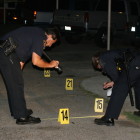
Webinar Examines Sexual Exploitation of Girls by Gangs
|
CHICAGO-- Although gangs are a chronic problem in many urban and suburban areas of the nation, this city included, certain aspects of gang life don’t receive the attention – and therefore the resources – necessary to combat them. In particular, the sexual exploitation of girls by gangs is a serious problem currently facing law enforcement, courts, educators and social service programs across the country, according to a panel that met this week to discuss the issue. The Office of Juvenile Justice and Delinquency Prevention presented a webinar Wednesday through the Missing and Exploited Children’s Program to address promising practices for targeting the commercial sexual exploitation of girls in gangs. The webinar built on MECP’s June presentation about exploitation by offering organizations and individuals suggestions for internal practices and appropriate interaction with victims.
“The top thing that sexually abused, victimized girls say they want in treatment and in custody is someone to talk to,” said speaker Keith Burt, a retired deputy district attorney and former Chief of the Gang Prosecution Division in San Diego. “Someone they feel they can trust, that they can just talk to.”
Although the speakers acknowledged males and transgender individuals suffer from sexual exploitation by gangs, the victims are overwhelmingly female.

